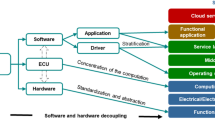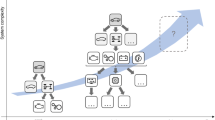Abstract
This paper presents a modeling approach for the development of software for electronic control units in the automotive domain. The approach supports the development of two related architecture models in the overall development process: the logical architecture provides a graphical, quite abstract representation of a typically large set of automotive functions. On this abstraction level no design decisions are taken. The technical architecture provides a software and a hardware representation in separated views: the software architecture describes the software realization of functions as software components, whereas the hardware architecture models hardware ntities, on which the software components are deployed. Logical as well as technical architectures only model structural information, but no behavioural information. A tight integration of both architecture levels—on the conceptual and on the tool level—with related development phases such as requirements engineering, behaviour modeling, code generation as well as version and configuration management resulting in a seamless overall development process is presented. This architecture modeling approach has been developed within a safety-relevant project at BMW Group. Positive as well as negative experiences with the application of this approach are described.
Similar content being viewed by others
References
Frischkorn H.G. (2004) Automotive software—the silent revolution. Automotive Software Workshop, San Diego
Heinecke H., et al. (2003) AUTOSAR—an industry-wide initiative to manage the complexity of emerging Automotive E/E-Architectures. Electronic Systems for Vehicles VDI Congress, Baden-Baden
Scharnhorst, Th., Heinecke H., Schnelle K.-P., Fennel H., Bortolazzi J., Lundh L., Heitkämper P., Leflour J., Mate J.-L., Nishikawa K. AUTOSAR—challenges and achievements 2005, Electronic Systems for Vehicles, VDI Congress, Baden-Baden, VDI Berichte Nr. 1907, p. 395–408 (2005)
Selic B., Gullekson G., Ward P.T. (1994) Real-time object-oriented modeling. Wiley, New York
Jeckle M., Rupp, Ch., Hahn J., Zengler B., Queins, St.: UML 2.0 glasklar, Hanser, (2004)
Henderson-Sellers B. (2005) UML—the Good, the Bad or the Ugly? Perspectives from a panel of experts. Int. J. Softw. Syst. Model. (SoSyM), 4(1): 4–13
Kobryn C. (2004) UML 3.0 and the future of modeling. Int. J. Softw. Syst. Model. (SoSyM) 3(1): 4–8
UML 2.0 Superstructure Specification: formal/05-07-04, Object Management Group (OMG), http://www.omg.org/technology/documents/formal/uml.htm
von der Beeck M. (2005) Function net modeling with UML-RT: experiences from an automotive project at BMW Group, <<UML>> 2004 Satellite Activities, Industry Track, Springer. Lect. Notes Comput. Sci. 3297, 94–104
Medvidovic N., Taylor R.N. (2000) A classification and comparison framework for software architecture description languages. IEEE Trans. Softw. Eng. 26(1): 70–93
Brown A.W. (2004) Model driven architecture: principles and practice. Int. J. Softw. Syst. Model. (SoSyM), 3, 314–327
France R., Rumpe B. (2005) Domain specific modeling, (Editorial). Int. J. Softw. Syst. Model. (SoSyM), 4(1): 1–3
Rational Rose RealTime: http://www.rational.com and http://www-306.ibm.com/software/awdtools/developer/technical/
ASCET SD: http://en.etasgroup.com/products/ascet
von der Beeck M. A concise compositional statecharts semantics definition, FORTE / PSTV 2000, pp. 335–350, Kluwer, Dordrecht (2000)
von der Beeck M. (2002) A structured operational semantics for UML-statecharts, Int. J. Softw. Syst. Model. (SoSyM), 1(2): 130–141
DOORS: http://www.telelogic.com/products/doorsers/
Milner R. (1989) Communication and concurrency. Prentice Hall, Englewood cliffs
Hoare C. (1985) Communication sequential processes. Prentice Hall, Englewood cliffs
CM Synergy: http://www.telelogic.com/products/synergy/
Medvidovic N., Rosenblum D., Redmiles F., Robbins J. (2002) Modeling software architectures in the unified modeling language. ACM Trans. Softw. Eng. Methodol. 11(1): 2–57
Saul, Th., Titze A., Bikker G., Lawrenz W. Graphical formalization of automobile electronics to evaluate architectures at an early stage of development. Electronic Systems for Vehicles, VDI Congress, Baden-Baden, VDI Berichte Nr. 1907, pp. 535–562 (2005)
EAST-EEA Embedded Electronic Architecture, Deliverable D3.6, Definition of language for automotive embedded electronic architecture, http://www.east-eea.net
SysML (Systems Modeling Language), http://www.sysml.org
Belschner R., Freess J., Mroßko M. Gesamtheitlicher Entwicklungsansatz für Entwurf, Dokumentation und Bewertung von E/E-Architekturen, Electronic Systems for Vehicles, VDI Congress, Baden-Baden, VDI Berichte Nr. 1907, pp. 511–521 (2005)
Author information
Authors and Affiliations
Corresponding author
Additional information
Communicated Ana Moreira and Thomas Baar.
Rights and permissions
About this article
Cite this article
von der Beeck, M. Development of logical and technical architectures for automotive systems. Softw Syst Model 6, 205–219 (2007). https://doi.org/10.1007/s10270-006-0022-z
Received:
Accepted:
Published:
Issue Date:
DOI: https://doi.org/10.1007/s10270-006-0022-z




